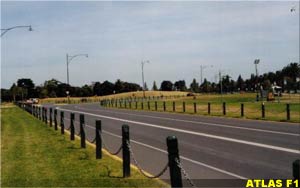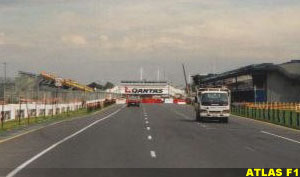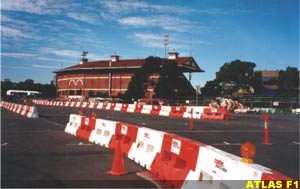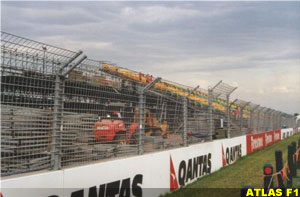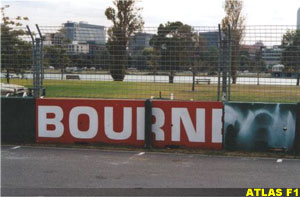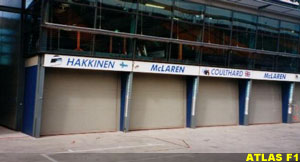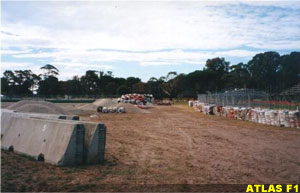| ATLAS F1 Volume 7, Issue 9 | |||
 |
Aspects of Albert Park | ||
| by Mark Glendenning, Australia | |||
|
In a series of articles, Mark Glendenning looks back at the history of motor racing at the current home of the Australian GP, Albert Park. In the fourth and final part of the series, we look at how the circuit has been prepared for this year's race
Part IV: the Making of the 2001 Australian GP
Were it not for the unexpected tightness of some of the corners and the pit building that rises monolithically from the sporting fields, you could easily spend most of the year driving around Albert Park Lake completely unaware that you are on an active Grand Prix circuit. There are no grandstands, no overpasses, and no advertising. Small wooden fence posts linked to one another with chain run along the roadside in place of the massive steel and concrete crash barriers that prevent errant car parts entering the crowd after something has gone amiss during the race.
Converting a large area of parkland into a venue capable of handling the demands of Formula One, and all it brings with it, is no small task. To help you get some feeling for the transformation that the park undergoes each year in preparation for the first weekend in March, I made regular visits to the track between the middle of January and late February to track how the work progressed.
Early to Mid January
The race circuit is comprised of two major roads - Aughtie Drive, which encompasses the start/finish straight as it runs between Turn 14 and Turn 5, and Lakeside Drive, which extends from Turn 6 to Turn 13. Albert Park Drive serves as the short blast between Turns 5 and 6, while Ross Gregory Drive connects Turns 13 and 14 to complete the track.
While at this early stage there is little to see, it is obvious that something is afoot, although all attention has thus far been directed towards Aughtie Drive. Strings of orange construction site flags flutter in the breeze at seemingly random spots around the lake, while small trucks and vans buzz importantly up and down the roads. Steel frames have begun to sprout from the grass-like bamboo forests, marking out the first signs of grandstands and corporate boxes. At this stage, it's still possible to climb the stairs up toward the podium without being intercepted by a large security guard wearing mirrored sunglasses.
Early February
It's been two weeks since my last visit, and much progress has been made. The most obvious sign of things to come is the massive Qantas arch that straddles the main straight just past the start/finish line and pitlane exit. By far the biggest overpass at the circuit, the arch is already in place by the end of January and stands watch over the happenings along the main straight for the next month. The skeletal frame along the main straight has started to sprout seats - the large Fangio stand is approximately half complete. Tangles of scaffolding elsewhere along the southern part of the track suggest the beginnings of most of the other stands, though there is no sign yet of the Prost stand, which is located at the final corner.
Turn 4 doesn't exist yet. During the non-race part of the year, the area between Turns 3 and 5 are linked by a narrow service road infested with speed humps that runs alongside a carpark. When this section is reconfigured for the race, the service road is closed off and the track is redirected through the parking area. Plastic barriers mark the route that the track will take in a few weeks time, but for the time being this part remains closed. Further along, the small corporate stands at Turn 5 appear to be half complete.
Heading along the leafy straight between Turns 5 and 6, I encounter an army of workmen and trucks who are busy setting up more concrete barriers. The incessant beeping of trucks reversing against a background of steadily chattering sprinklers creates a feeling that all these guys in hard hats and fluorescent jackets are labouring to a soundtrack created by a cheap 1980s synthesizer. A stark white pedestrian overpass has been set up and awaits painting.
With the exception of some scaffolding that will soon become grandstands and corporate facilities, there is little race infrastructure in place between the chicane and Turn 13. A proliferation of small orange flags suggests that this will soon change.
A Week Later
The area is starting to feel like a race circuit now, and security has been bumped up accordingly. For the first time this year, I spot a security guy on a bike, a sight that becomes more and more common as the race looms nearer. Near Turn 3, a huge crane is maneuvering the main section of an overpass into position.
All of the gravel traps have been marked out with tyres, but none have been installed yet.
Mid-late February
The race is a little over two weeks away. All the grandstands and corporate facilities appear close to completion, and I'm particularly happy to see that the podium backdrop is in place, even if, for the time being, it is a rather dull black. I'm tempted to head on up for a better look, but the mirrored sunglasses guy standing near the bottom of the steps makes me reconsider. Instead, I amuse myself by wandering along the pitlane.
Sprinklers frantically spray water all over the grassed areas alongside Lakeside Drive, trying to keep the grass green in the face of an oppressive Melbourne heatwave. The theory behind this is that it will help make the track surrounds look more appealing on television. Come race day though, this particular area will be so full of people that the grass will be invisible to the television audience, and trampled to death. Still, it's a nice thought. If by some miracle when you are watching the race you happen to see a patch of grass in the spectator area near the chicane, be sure to acknowledge how lush and green it looks. The organisers have gone to a lot of trouble.
Elsewhere on the circuit, the barriers have all been installed and treated to a fresh undercoat. The 2001 advertising has not been added yet, though I seem to remember from previous years that this is usually done quite late. Some of the gravel traps are now under construction, with the large runoff area at Turn 12 being closest to completion. The road at Turn 4 has now been adapted to race configuration, and for the first time it's possible to drive through Turn 4. The Turn 9/10 chicane is under construction, but still appears to be a couple of days from completion.
In the following week, the barriers will be touched up, the gravel traps will be installed and in typical Melbourne style, painted garishly. Then there are the smaller, less obvious things that need to be done. Sensors need to be installed at various points around the track. The pitwall needs to be set up. The starting lights need to be hung from the gantry. The superscreens need to be erected. And twelve Formula One teams need to arrive and set up camp. How will the whole thing look when it's finally done? Tune in on March 4th to find out. Then, when it's all over and the circus moves to Malaysia, the process of dismantling the circuit will begin, and the tangible parts of the Australian Grand Prix will be packed away in mothballs until December, when the whole process will begin again in preparation for 2002...
|
| Mark Glendenning | © 2007 autosport.com |
| Send comments to: glendenning@atlasf1.com | Terms & Conditions |
